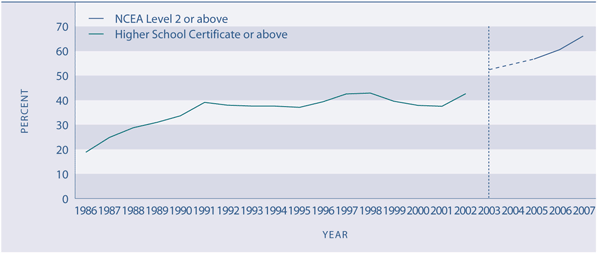School leavers with higher qualifications
Definition
The proportion of secondary school leavers who left school with a
qualification at National Certificate of Educational Achievement (NCEA)
Level 2 or above.
Relevance
Upper secondary school qualifications serve as the foundation
for higher (post-secondary) learning and training opportunities as well
as the preparation for direct entry into the labour market. Those who
leave school early with few qualifications are at a much greater risk
of unemployment or vulnerability in the labour force and of having low
incomes.49
Current level and trends
In 2007, 66 percent of school leavers (37,000 students) left
school with a qualification at NCEA Level 2 or above, an increase from
the 2006 figure of 60 percent (34,000 students).50 Because of changes in the
qualification structure, it is not possible to compare exactly the
attainment of upper secondary school students who left school before
2003 with those who left school in 2003 and later. To illustrate the
trend in higher school attainment over the long term, Figure K2.1
includes the proportion of school leavers who left with Higher School
Certificate and above for the years 1986 to 2002.
Figure K2.1 Proportion of school leavers
with Higher School Certificate or above, 1986–2002 and NCEA Level 2 or
above, 2003, 2005–2007

Source: Ministry of Education
Notes: (1) A direct comparison cannot be made between rates up to and
including 2002 with rates for 2003 on, due to the change in the
qualification structure (see Appendix 2 for details) (2) Because of
methodological changes, 2004 is not comparable with other years and has
been omitted
Sex differences
Female students are more likely than male students to leave
school with an upper secondary school qualification. Between 2006 and
2007, the proportion of school leavers with NCEA Level 2 or above
increased for both sexes but there was a slightly larger increase for
females than for males. As a result, the sex difference in school
attainment widened slightly between 2006 and 2007, from 8.7 percentage
points to 9.3 percentage points.
Table K2.1 Proportion (%) of school
leavers with NCEA Level 2 or above, by sex, 2003, 2005–2007
| |
Males |
Females |
| 2003 |
47.6 |
57.9 |
| 2005 |
52.0 |
62.3 |
| 2006 |
55.8 |
64.5 |
| 2007 |
60.9 |
70.2 |
Source: Ministry of Education
Note: Because of methodological changes, 2004 is not comparable with
other years and has been omitted
Ethnic differences
The proportion of school leavers with upper secondary school
qualifications varies widely by ethnic group. Asian students who left
school in 2007 had the highest proportion with NCEA Level 2 or above,
followed by European school leavers, then Pacific and Māori school
leavers. Between 2006 and 2007, there was an increase for all ethnic
groups in the proportion of students leaving with a qualification at
NCEA Level 2 or above. The increase was greater for Māori and Pacific
students than for European and Asian students.
Table K2.2 Proportion (%) of school
leavers with NCEA Level 2 or above, by ethnic group, 2003, 2005–2007
| |
European |
Māori |
Pacific peoples
|
Asian |
Other |
Total |
| 2003 |
57.4 |
28.8 |
42.3 |
75.1 |
54.2 |
52.6 |
| 2005 |
63.0 |
32.7 |
45.3 |
79.9 |
55.8 |
57.1 |
| 2006 |
65.4 |
36.7 |
49.6 |
82.2 |
63.5 |
60.2 |
| 2007 |
70.6 |
43.9 |
56.0 |
84.2 |
67.0 |
65.5 |
Source: Ministry of Education
Note: Because of methodological changes, 2004 is not comparable with
other years and has been omitted
Socio-economic differences
Young people from schools that draw their students from low
socio-economic communities are less likely than other young people to
attain higher school qualifications. In 2007, only 49 percent of school
leavers from deciles 1–3 schools (in the most disadvantaged
communities) attained qualifications at NCEA Level 2 or above, compared
with 62 percent of those leaving deciles 4–7 schools and 79 percent of
those leaving deciles 8–10 schools.
Regional differences
The Otago, Wellington and Auckland regions had the highest
proportion (70 percent) of 2007 school leavers with qualifications at
NCEA Level 2 or above, followed by Canterbury (68 percent). The West
Coast had the lowest proportion (45 percent), followed by Gisborne (55
percent) and Tasman (57 percent). |

